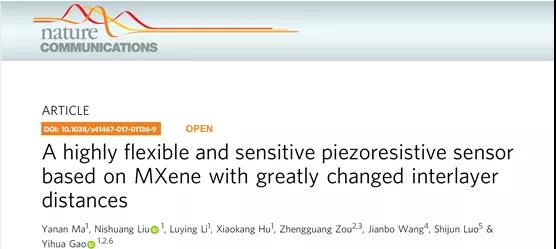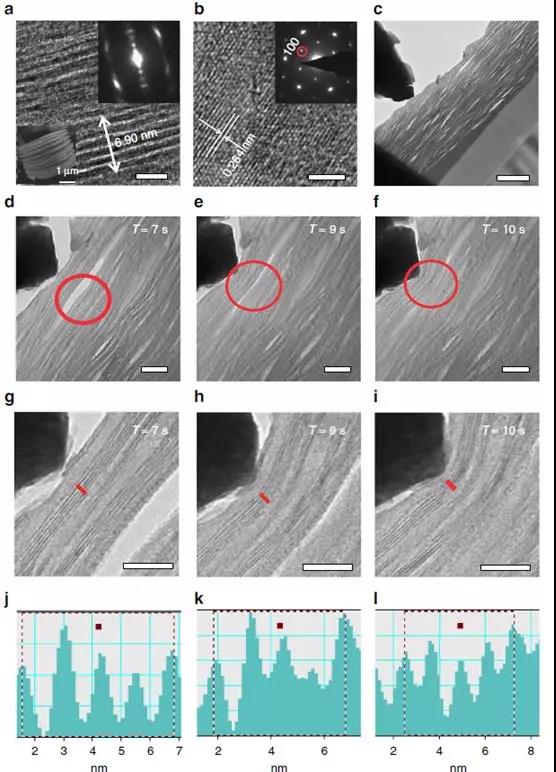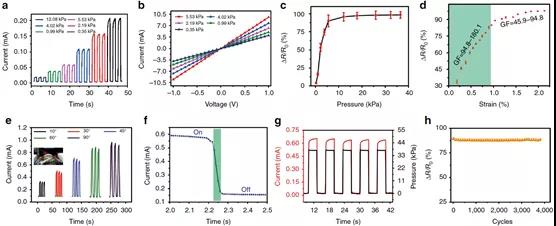
hotline:
17715390137
Tel/Wechat:
18101240246 (Technology)
0512-68565571
Email:mxenes@163.com (Sales Engineer)bkxc.bonnie@gmail.com
Scan the code to follow or search the official account on WeChat:
2D Materials Fronrier After paying attention,
click on the lower right corner to contact us,
Enter enterprise WeChat.
Professional Services Online


【Research Background】
Similar to graphene, MXenes materials have excellent properties such as large specific surface area, high electrical conductivity, and good strength. Based on the above characteristics, MXenes materials have many important applications, such as water purification, lithium ion batteries, super capacitors and so on. However, since MXenes are prepared by selectively etching away the "A" layer elements of the MAX phase, the adjacent layer spacing of the MXenes can be simply controlled by compression. Therefore, pressure sensors can be prepared from MXenes materials.
Currently, there are three main types of pressure sensors, piezoelectric, piezoresistive and capacitive. Among them, the piezoresistive sensor is a kind of sensor that converts external pressure into a resistance signal, which is widely concerned due to its low manufacturing cost, easy signal acquisition, and important applications in smart displays, skin sensing electronic devices and portable medical monitors. .
Carbon materials and their composite materials are widely used in high-sensitivity flexible retractable piezoresistive sensors due to their macroscopic structural deformation characteristics. However, due to the complicated preparation process and the shortcomings of the structure of the carbon material itself, scientists are prompted to find new materials or structures with simple inter-layer atomic motion to reduce costs and simplify steps, especially important to improve sensitivity to meet Realistic requirements. Due to the wide distance between the layers of MXenes, it has high sensitivity and flexibility under external pressure, which can meet the requirements for detecting fine activities such as human blinking and cheek bulging.
[Introduction]
In 2017, Gao Yihua, a professor of physics at Huazhong University of Science and Technology and professor of Wuhan Optoelectronics National Laboratory, developed a flexible piezoelectric sensor based on Ti3C2-MXene, which has fast response, high compressibility and sensitivity, and The series of human body responses were tested. The results are published online in Nature Communications: A highly flexible and sensitive piezoresistive sensor based on MXene with greatly changed interlayer distances
[Graphic introduction]

Figure 1. Microstructure of the MXenes piezoresistive sensor: (a) Under external forces, the distance between two adjacent MXenes sandwiches in the sensor is reduced. The wide spacing (Dw) between the two layers is easier to compress and the narrower (Dn) compression ratio is smaller, (b) the equivalent circuit diagram of the MXenes based piezoresistive sensor, where the total resistance is reduced by the distance reduction .

Figure 2 shows the typical microstructure of MXenes and the in-situ dynamic process under external forces. (a) TEM image of the cross section of MXenes, internal image showing layered structure, (b) HRTEM image of the top view of MXenes, internal corresponding diffraction pattern, showing good hexagonal features, (c) in the original In the force gauge, a nanoindenter supported by a conical tip was applied locally to the FIB treated MXenes sample. (d)-(f) Under the action of external force, the wider distance in MXenes decreases rapidly from ~12 nm to ~3 nm to ~0 nm in 7, 9, and 10 s, (g)-(i The narrower distances (four intervals) marked with red lines were 5.23 nm, 4.98 nm, and 4.81 nm, respectively, and (j)-(l) were analyzed using digital photomicrography software. From the initial state of g, the strain values of the h and i states were 4.78 and 8.03%, respectively. a, b is 4 nm, c is 200 nm, d-f is 40 nm, and g-i is 20 nm.

Figure 3 Pressure response of the MXenes sensor. (a) I-T curve at 13 kPa pressure. The current increases monotonically with increasing pressure. (b) The linear relationship of the IV curve indicates the ohmic contact between the MXenes and the interdigital electrodes. (c) When the pressure is less than 5 kPa, the ΔR /Roff increases sharply as a function of pressure. At 5 kPa, the growth rate slows down. The SD of the data displayed by the error bars is in the range of 1.44-8.21%, calculated by analyzing five sets of data for each pressure, and (d) the relationship between ΔR / Roff and strain. The GF is up to 180.1. The SD of the data represented by the error bars is in the range of 0.26-1.78%, which is calculated by analyzing four sets of data under each strain value, (e) the IT relationship at different bending angles, and (f) an IT curve. Partial magnification shows that its response time is less than 30 milliseconds. (g) The output current and external pressure are kept in good synchronization when the load is increased or removed. (h) The resistance change rate ΔR / Roff maintains good stability.

Figure 4 MXenes sensors are used to explore human activities. The current changes of the sensor caused by small changes such as blink (a), cheek swelling (b), and throat swallowing (c) are accurately recorded, (d)-(f) elbow joint (d), finger (e), and The sensor current change caused by the bending-extension of the ankle (f), (g) the knee curve-extension of the IT curve, and (h) the sensor in series with the micro-circuit implanted with Bluetooth, converting the current signal into a cell phone signal, (i) The knee motion of the Bluetooth-incorporated microcircuit is very similar in amplitude and shape to the knee motion of the Agilent device, but at a faster frequency.

The 4 x 4 micron sensor array prepared in Figure 5. (a) The 4×4 MXenes sensor pixel array detects the pressure distribution (scale is 5 mm), (b) a watch placed on the sensor array, and (c) records and measures the output of each pixel. The color contrast is consistent with the position of the watch in figure b when c maps the local pressure distribution.
[Summary of this article]
According to the basic characteristics of large changes in interlayer distance under external force, a highly flexible and sensitive MXenes piezoresistive sensor was developed. In situ TEM studies directly clarify the basic working mechanism of piezoresistive sensors. The sensor has fast response and good stability, and has a wide range of applications in detecting small human activities and other weak pressures. The GF value of this paper reached 180.1, which was significantly higher than other reports. This is the first piezoresistive sensor to utilize MXenes (Ti3C2), opening up a new field for other MXenes applications.
Literature link
Https://doi.org/10.1038/s41467-017-01136-9
Source: WeChat public account MXene Frontier

| Reminder: Beijing Beike New Material Technology Co., Ltd. supplies products only for scientific research, not for humans |
| All rights reserved © 2019 beijing beike new material Technology Co., Ltd 京ICP备16054715-2号 |